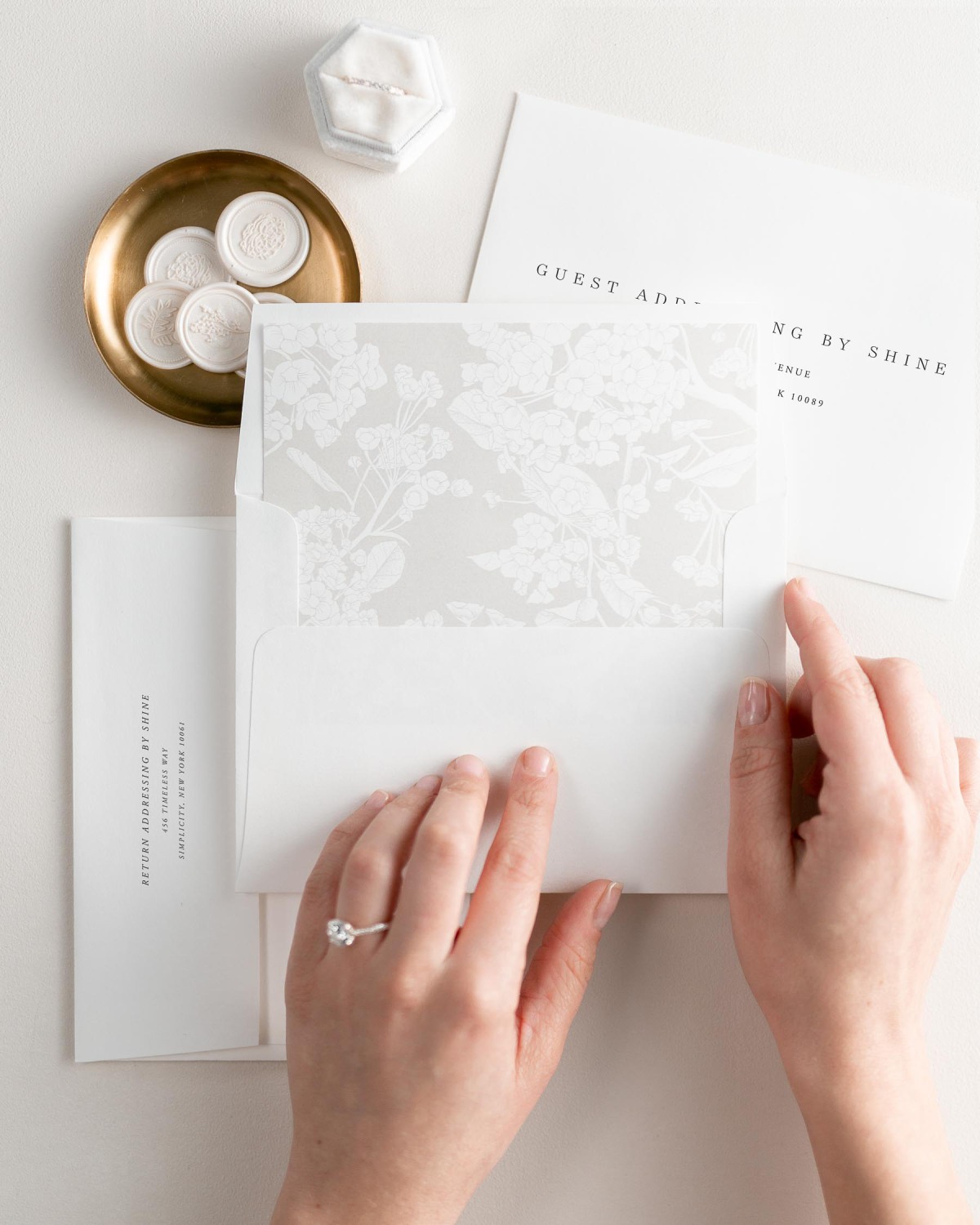
Single Envelopes
A single envelope is a more casual and simple option for wedding invitations. Single envelopes are cost effective but lose the formality and protection of double envelopes.
When using a single envelope, guest’s names and addresses are printed directly on the envelope just as you would for the outer envelope of double envelopes. This option omits listing out family members and instead includes a generic term, like “guest” or “family”.
Single envelopes have gumming on the flap to make sealing easy and can also be lined.

Double Envelopes
Double envelopes, also known as inner and outer envelopes, are a more formal and traditional option according to etiquette. They offer protection from mail damage and clarify exactly who is invited to your event.
The outer envelope protects the inner envelope and invitation from the abuse of the mail system. Only the inner envelope will be lined if that option is selected, since the outer envelope will be thrown away. The inner envelope acts as a folder for your guests to neatly store their invitation and its components. The flap of the inner envelope isn’t gummed, resulting in a clean look.
Double envelopes also allow you to clarify exactly who is invited to your event. The outer envelope will be addressed to the household and each individual guest’s name will be printed on the inner envelope. This clearly indicates whether children or other household members are invited or not and prevents confusion and unwanted guests.
Double envelopes are required for suites with ribbon or letterpress printing.
Common Questions
WHAT IS THE DIFFERENCE BETWEEN INNER AND OUTER ENVELOPES?
When it comes to wedding invitations, you have the option of choosing between single and double envelopes. Single envelopes are a more budget-friendly option, as they only require one envelope to be mailed. However, they do not provide as much protection for your wedding invitations during mailing. Double envelopes, on the other hand, offer an added layer of protection and are considered a more formal option according to etiquette. Double envelopes also provide a unique advantage by allowing you to include additional information on the inner envelope, such as the names of each invited guest. This thoughtful detail not only creates a favorable impression but also alleviates any confusion for your guests regarding who is invited.
WHY DO FORMAL INVITATIONS HAVE TWO ENVELOPES?
Formal invitations have two envelopes because that’s what should be used according to etiquette. The outer envelope is sealed, with the guest’s name and address written on it, while the inner envelope is left unsealed and contains the actual invitation. The inner envelope is then used to address the invitation more personally, often including the names of each invited guest. This clarifies exactly who is invited to the event, and prevents confusion as to whether children or additional household members are included. The double envelope system also provides an extra layer of protection for the invitation during shipping and handling, ensuring that it arrives in pristine condition.
WHAT IS A DOUBLE ENVELOPE?
A double envelope is a set of two envelopes used to enclose an invitation or formal correspondence. The inner envelope is typically smaller and is meant to hold the invitation, while the outer envelope is slightly larger and serves as a protective layer during mailing. Double envelopes are often used for formal events such as weddings, galas, or business functions, and are considered a traditional and elegant way to present invitations. The use of double envelopes adds an extra layer of formality and sophistication to the presentation of invitations, as well a way to indicate exactly who is invited on the inner envelope.
DO ALL WEDDING INVITATIONS HAVE TWO ENVELOPES?
While double envelopes are a traditional and formal option, they are not required for all weddings. At Shine Wedding Invitations, we highly recommend using double envelopes for invitations that need extra protection, like silk ribbon wedding invitations and letterpress wedding invitations. Many modern couples opt for a simpler and more streamlined approach, using a single envelope for their invitations. Ultimately, the decision to use one or two envelopes will depend on personal preference, budget, and the overall style and formality of the wedding.
HOW DO YOU ADDRESS A WEDDING INVITATION WITH ONLY ONE ENVELOPE?
The basic format for addressing a wedding invitation includes the names of the guests being invited with their formal titles, and the address where the invitation is being sent. For example, “Mr. and Mrs. Oliver Bennett, 123 Main Street, Anytown.” If you are inviting guests with different last names or titles, you may need to list each individual separately on the envelope. It is also recommended to use formal titles, such as “Mr.,” “Mrs.,” or “Dr.,” unless you have been instructed otherwise by the couple. If you want a more modern approach, you can list out the names as “Mr. Oliver and Mrs. Nora Bennett, 123 Main Street, Anytown”. We also recommend spelling out all information, including street name, city, and state.




